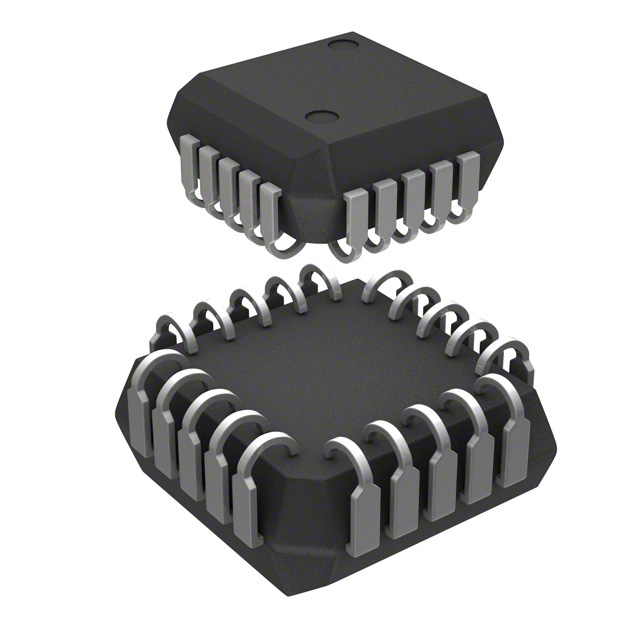Viz Specifikace pro podrobnosti o produktu.

AT17C010-10JC
Product Overview
Category
AT17C010-10JC belongs to the category of non-volatile memory devices.
Use
This product is primarily used for storing and retrieving data in electronic systems.
Characteristics
- Non-volatile: The stored data is retained even when power is removed.
- High capacity: The AT17C010-10JC has a storage capacity of 1 megabit (128 kilobytes).
- Low power consumption: It operates at a low voltage and consumes minimal power.
- Fast access time: The device provides quick access to stored data.
- Reliable: The AT17C010-10JC offers high endurance and data retention reliability.
Package
The AT17C010-10JC is available in a 32-pin PLCC (Plastic Leaded Chip Carrier) package.
Essence
The essence of this product lies in its ability to provide non-volatile storage with high capacity and fast access times.
Packaging/Quantity
The AT17C010-10JC is typically packaged in reels or tubes, with a quantity of 100 units per reel/tube.
Specifications
- Memory Capacity: 1 Megabit (128 Kilobytes)
- Operating Voltage: 2.7V - 5.5V
- Access Time: 100 nanoseconds
- Operating Temperature Range: -40°C to +85°C
- Data Retention: 10 years
Detailed Pin Configuration
The AT17C010-10JC has a total of 32 pins, which are assigned specific functions. The pin configuration is as follows:
- VCC - Power supply voltage
- GND - Ground
- A0-A16 - Address inputs
- CE - Chip Enable
- OE - Output Enable
- WE - Write Enable
- NC - No Connection
- DQ0-DQ7 - Data inputs/outputs
Functional Features
- Random access: The AT17C010-10JC allows for random access to any location within the memory array.
- Byte-wise programming: It supports byte-wise programming, enabling efficient data storage and retrieval.
- Hardware write protection: The device offers hardware-based write protection to prevent accidental data modification.
- High endurance: The AT17C010-10JC can withstand a high number of erase/write cycles.
Advantages and Disadvantages
Advantages
- Non-volatile storage ensures data retention even during power loss.
- High capacity allows for storing large amounts of data.
- Low power consumption prolongs battery life in portable devices.
- Fast access time enables quick retrieval of stored information.
- Reliable performance ensures data integrity over extended periods.
Disadvantages
- Limited storage capacity compared to other modern non-volatile memory technologies.
- Relatively slower access times compared to volatile memory devices.
Working Principles
The AT17C010-10JC utilizes electrically erasable programmable read-only memory (EEPROM) technology. It stores data by trapping charges in floating gate transistors, which can be electrically erased and reprogrammed. When data is written, the charges are trapped, and they remain stored even when power is removed. During read operations, the trapped charges are detected, allowing the retrieval of stored data.
Detailed Application Field Plans
The AT17C010-10JC finds applications in various electronic systems, including but not limited to: - Embedded systems - Industrial control systems - Automotive electronics - Consumer electronics - Communication devices
Its non-volatile nature, high endurance, and reliable performance make it suitable for applications that require long-term data storage and retrieval.
Detailed and Complete Alternative Models
- AT17C020-10JC: Similar to AT17C010-10JC but with double the storage capacity (2 megabits).
- AT17C040-10JC: Offers four times the storage capacity of AT17C010-10JC (4 megabits).
- AT17C080-10JC: Provides eight times the storage capacity of AT17C010-10JC (8 megabits).
These alternative models offer increased storage capacities while maintaining similar characteristics and functionality to the AT17C010-10JC.
In conclusion, the AT17C010-10JC is a non-volatile memory device that offers high-capacity data storage, fast access times, and low power consumption. Its reliable performance and various applications make it a valuable component in electronic systems.
Seznam 10 běžných otázek a odpovědí souvisejících s aplikací AT17C010-10JC v technických řešeních
Sure! Here are 10 common questions and answers related to the application of AT17C010-10JC in technical solutions:
Q: What is AT17C010-10JC? A: AT17C010-10JC is a specific model of EEPROM (Electrically Erasable Programmable Read-Only Memory) manufactured by Microchip Technology.
Q: What is the capacity of AT17C010-10JC? A: AT17C010-10JC has a capacity of 1 Megabit, which is equivalent to 128 Kilobytes.
Q: What is the operating voltage range for AT17C010-10JC? A: The operating voltage range for AT17C010-10JC is typically between 4.5V and 5.5V.
Q: Can AT17C010-10JC be used in automotive applications? A: Yes, AT17C010-10JC is suitable for automotive applications as it can withstand the required temperature and voltage ranges.
Q: How fast is the data transfer rate of AT17C010-10JC? A: The data transfer rate of AT17C010-10JC is 10 MHz, allowing for relatively fast read and write operations.
Q: Is AT17C010-10JC compatible with microcontrollers? A: Yes, AT17C010-10JC is compatible with most microcontrollers that support SPI (Serial Peripheral Interface) communication.
Q: Can AT17C010-10JC be reprogrammed multiple times? A: Yes, AT17C010-10JC is an EEPROM, which means it can be electrically erased and reprogrammed multiple times.
Q: Does AT17C010-10JC require an external power supply? A: Yes, AT17C010-10JC requires an external power supply within the specified voltage range for proper operation.
Q: What is the typical data retention period of AT17C010-10JC? A: The typical data retention period of AT17C010-10JC is 10 years, ensuring long-term storage of information.
Q: Can AT17C010-10JC be used in low-power applications? A: Yes, AT17C010-10JC has a low standby current consumption, making it suitable for low-power applications where energy efficiency is important.
Please note that these answers are general and may vary depending on specific application requirements and datasheet specifications.

